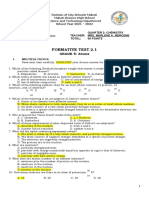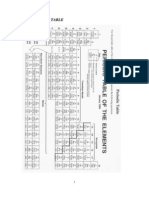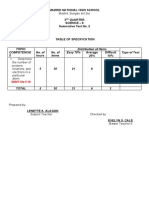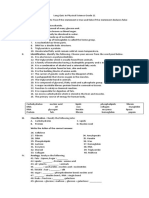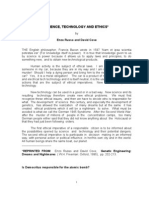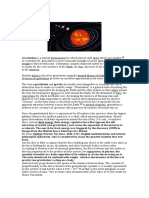Subatomic Particles Worksheet
Uploaded by
Rukaya ShmaraSubatomic Particles Worksheet
Uploaded by
Rukaya ShmaraName: ____________________
Date: _____________________
Subatomic Particles
1. How can you use the periodic table to determine the number of protons in an atom? Look at atomic number at the top
_________________________
2. a) How can you determine the number of electrons in an atom?The
_____________________________________
number of electrons in a neutral atom equal to the number
for proton
They have to be equal for the atom to neutral.
b) Why do the number of electrons and protons have to be equal? ___________________________________
3. a) How can you determine the number of neutrons in an atom? Subtract
_____________________________________
number of proton from the mass
________________________________________________________________________________________
b) How can you tell the atomic number from the atomic mass on the periodic table?
The atomic number is where the element is placed on the periodic table at the top and the mass is on the bottom.
________________________________________________________________________________________
4. Use the periodic table to complete the table below with the correct information for each atom. Round the atomic
mass to the nearest whole number for the mass number.
Element name Element Atomic Mass Number of Number of Number of
symbol number number protons neutrons electrons
hydrogen
helium
lithium
beryllium
boron
carbon
nitrogen
oxygen
fluorine
neon
sodium
magnesium
aluminum
silicon
phosphorus
sulfur
chlorine
argon
potassium
calcium
5. Yes
a) Do all atoms of the same element contain the same number of protons? ______________
b) Explain. _______________________________________________________________________________
The number of proton is the atomic number so if it has a different then it’s not the same element
________________________________________________________________________________________
6. a) Do all atoms of the same element contain the same number of neutrons? _______________
No
Atoms can have different number of neutrons (isotopes)
b) Explain. _______________________________________________________________________________
________________________________________________________________________________________
7. a) How many neutrons are there in most potassium atoms? ____________________
20
22
b) How many neutrons are there in potassium-41 (potassium with an atomic mass of 41)? ________________
c) How many neutrons are there in the radioactive isotope potassium-40? ________________
21
8. 7
a) How many electrons are there in a neutral nitrogen atom? _________________
3-
10
b) How many electrons are there in N (a nitrogen ion with a charge of 3-)? _______________
5+ 2
c) How many electrons are there an N (a nitrogen ion with a charge of 5+)? ________________
You might also like
- Science 8 Q3 Periodic Exam Blooms Taxo With Answer Key100% (1)Science 8 Q3 Periodic Exam Blooms Taxo With Answer Key6 pages
- Grade 8 Summative Test (Matter) NAME: - YEAR & SEC.: - DATE: - SCORENo ratings yetGrade 8 Summative Test (Matter) NAME: - YEAR & SEC.: - DATE: - SCORE3 pages
- Diagnostic Test in Science Grade 8 Sy20 21No ratings yetDiagnostic Test in Science Grade 8 Sy20 213 pages
- Physical Science Midterm Exam (2ND Semester)100% (2)Physical Science Midterm Exam (2ND Semester)3 pages
- Atomic Number, Mass Number, Atomic Mass and IsotopesNo ratings yetAtomic Number, Mass Number, Atomic Mass and Isotopes21 pages
- THE PERIODIC TABLE - Multiple Choice Review Questions67% (6)THE PERIODIC TABLE - Multiple Choice Review Questions5 pages
- w310 Protons Neutrons and Electrons Worksheet PDF0% (2)w310 Protons Neutrons and Electrons Worksheet PDF2 pages
- Science-Grade 9 Learner Activity Sheets Quarter 1-Week 5: Biodiversity and Species Extinction First Edition, 2021No ratings yetScience-Grade 9 Learner Activity Sheets Quarter 1-Week 5: Biodiversity and Species Extinction First Edition, 202110 pages
- Practice Sheet - 10 Inheritance and VariationNo ratings yetPractice Sheet - 10 Inheritance and Variation3 pages
- Science8 q1 Mod3 Potential-And-kinetic-Energy v2No ratings yetScience8 q1 Mod3 Potential-And-kinetic-Energy v223 pages
- Science 9 Quarter 1 Performance Task No. 2: MY FAMILY TRAITS TREENo ratings yetScience 9 Quarter 1 Performance Task No. 2: MY FAMILY TRAITS TREE2 pages
- Science 8 Third Quarter - Module 4 Periodic Table of Elements100% (1)Science 8 Third Quarter - Module 4 Periodic Table of Elements4 pages
- Dipolog City Science Ix: Zamboanga Del Norte National High School Science Department 1 Summative TestNo ratings yetDipolog City Science Ix: Zamboanga Del Norte National High School Science Department 1 Summative Test3 pages
- Atomic Number and Synthesis of New ElementsNo ratings yetAtomic Number and Synthesis of New Elements11 pages
- G9 Science Q4 - Week 1-2 Projectile MotionNo ratings yetG9 Science Q4 - Week 1-2 Projectile Motion24 pages
- 9.5 Determining The Number of Protons, Electrons, and NeutronsNo ratings yet9.5 Determining The Number of Protons, Electrons, and Neutrons5 pages
- Science: Quarter 3: Week 6 Learning Activity Sheets100% (4)Science: Quarter 3: Week 6 Learning Activity Sheets8 pages
- James Ruse 2020 Physics Trials & SolutionsNo ratings yetJames Ruse 2020 Physics Trials & Solutions59 pages
- Crystal Structure Determination: A Critical ViewNo ratings yetCrystal Structure Determination: A Critical View16 pages
- β-decay and its types: Department Of Chemistry Lahore College For Women UniversityNo ratings yetβ-decay and its types: Department Of Chemistry Lahore College For Women University9 pages
- Instant Download Quantum Chemistry: Classical to Computational 1st Edition Dua PDF All Chapters100% (1)Instant Download Quantum Chemistry: Classical to Computational 1st Edition Dua PDF All Chapters65 pages
- Excel Journal of Engineering Technology & Manaement ScienceNo ratings yetExcel Journal of Engineering Technology & Manaement Science121 pages
- Direct Nuclear Reactions and Compound Nucleus ReactionsNo ratings yetDirect Nuclear Reactions and Compound Nucleus Reactions5 pages
- SALAM Unification of Fundamental Forces PDFNo ratings yetSALAM Unification of Fundamental Forces PDF153 pages
- Daniel, Reyden R. Abm 11 Sy Reviewer in Physical ScienceNo ratings yetDaniel, Reyden R. Abm 11 Sy Reviewer in Physical Science23 pages
- Class 12 Physics Unit 5 Atoms and NucleicNo ratings yetClass 12 Physics Unit 5 Atoms and Nucleic6 pages
- Test Bank for The Human Body in Health and Disease 6th Edition - Full Book Is Now Available For Download100% (9)Test Bank for The Human Body in Health and Disease 6th Edition - Full Book Is Now Available For Download49 pages




